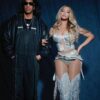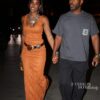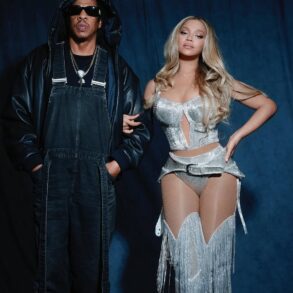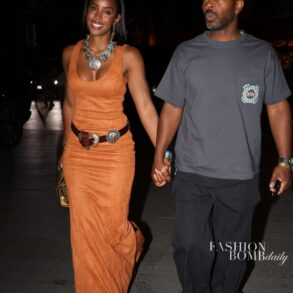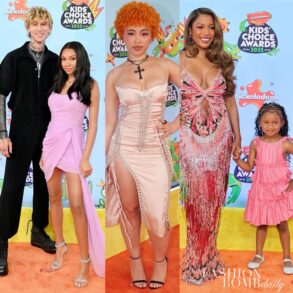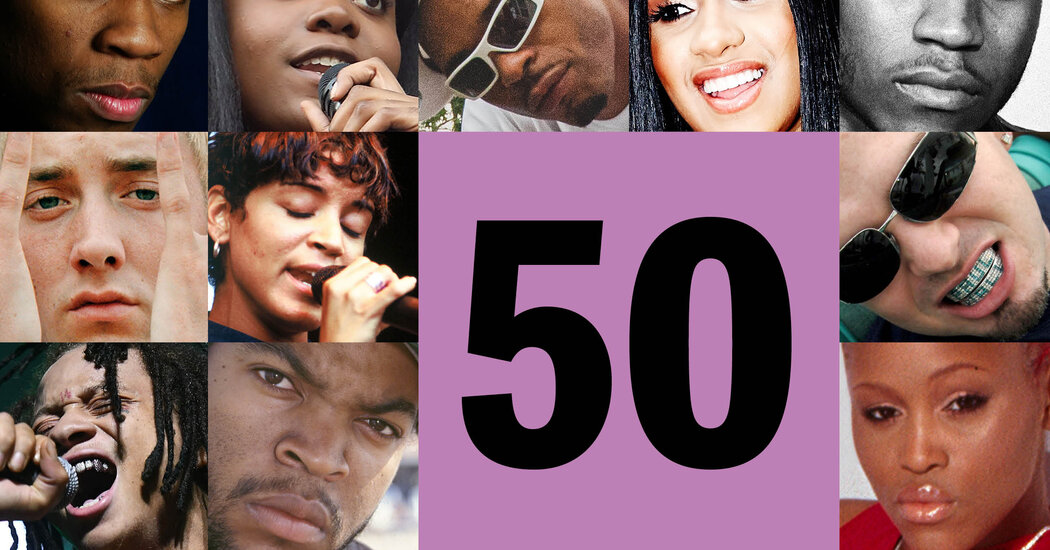
It’s the 50th anniversary of hip-hop. To celebrate, we invite students to explore its remarkable rise, its remaking of the global cultural landscape, and its legacy and future.
Over five decades, hip-hop has grown from a new art form to a culture-defining superpower. At first dismissed as a fad, often derided as a nuisance or a menace, hip-hop has become a multibillion-dollar industry and a global juggernaut — woven into nearly every corner of American life. Jon Caramanica, a New York Times music critic, writes:
It is a fount of constant innovation, and a historical text ripe for pilfering. It is a continuation of rock, soul and jazz traditions, while also explicitly loosening their cultural grip. It is evolving more rapidly than ever — new styles emerge yearly, or faster, multiplying the genre’s potential. And it has impact far beyond music: Hip-hop is woven into television and film, fashion, advertising, literature, politics and countless other corners of American life. It is lingua franca, impossible to avoid.
In this resource, we suggest eight teaching ideas for bringing hip-hop into your classroom — based largely on The Times’s multimedia package chronicling hip-hop’s 50th anniversary — including exploring the ingenuity and wit of rap lyrics and making predictions about the genre’s future.
Teachers, please let us know how you are teaching hip-hop in your classroom in the comments section or by emailing us at LNFeedback@nytimes.com.
1. Make personal connections.
Hip-hop is ubiquitous. Whether students are huge fans of the culture, everyone has a connection to it — big or small. Before diving into The New York Times’s coverage of the 50th anniversary, ask them to make personal connections to the genre.
Through journal writing or discussion, students can respond to one or more of these prompts:
-
What does hip-hop mean to you? What role does it play in your life?
-
Are you a big hip-hop fan? Do you go to shows? Create beats? Write or perform raps? Has hip-hop culture affected your style and dress?
-
What moments, artists, songs and lyrics stand out to you? Who are your favorite artists? Who would you say is the GOAT — the greatest rapper of all time?
-
What do you know about hip-hop and its 50-year history? What would you like to know more about?
Students can share their thoughts, experiences and opinions with teenagers from around the world in our related Student Opinion prompt.
2. Learn about hip-hop’s history from the artists themselves.
A centerpiece of The Times’s 50th anniversary coverage is a collection of oral histories gathered from hip-hop artists across generations, regions and styles. It includes testimonials from superstars like Lil Wayne, Cardi B and Eminem as well as from outlier champions like Trippie Redd and Slug. Here’s an excerpt from what 50 Cent said:
I fell in love with hip-hop, but it was only playing for one hour out the week on the radio. My grandmother used to go to church and take a tape recorder and record everything the minister said, and she would play Sunday service to herself again on like, Wednesday. She had all of these Maxell cassette tapes that once you record, you break the little tab off. I had to go get toilet paper and put it in the square and record over what she already had for the church. It was only on for one hour — I had to record it then.
To begin, students can take a quick tour of the entire collection. They can click through the interactive and listen to as many rappers as they can, taking notes on the names of each artist, the names of the featured songs and the years they were released. (Each testimonial has a song by the artist at the top of the interview.)
Then ask students to read at least three interviews from different eras of hip-hop, highlighting key biographical information as well as their favorite quotes and details.
Students, individually or in groups, can address these prompts:
-
Which rappers did you choose, and why?
-
What did you learn from their stories?
-
Which images, sounds, details and quotes stood out, and why?
-
What question would you ask one of these rappers, if you could?
Together as a class, they can discuss: What story do the oral histories tell us about hip-hop? How has the genre grown and evolved over its first five decades? What questions do you have about the oral histories or about hip-hop in general?
Another idea? Invite your students to make a 50th anniversary playlist: If some of them have never heard of hip-hop, or don’t like rap, what songs would you play for them to explain its meaning and significance, or to win them over? What would be on your essential hip-hop playlist?
3. Explore the lyrics.
To celebrate hip-hop’s birthday, The Times asked Mahogany L. Browne, Lincoln Center’s first poet-in-residence and an acclaimed author, to write a love letter to the genre, composed entirely of lyrics both beloved and obscure, with a little remixing.
The piece features lyrics from every decade of hip-hop, including from Slick Rick, LL Cool J, MC Lyte and Lil’ Kim, as well as from more recent artists like Ice Spice and Kendrick Lamar. Students can hover over a lyric to listen to the songs Ms. Browne sampled, or to learn more about them. Students can also hear the author read her piece all the way through.
A Hip-Hop Love Story in Lyrics
Read by Mahogany L. Browne.
Finally, there’s a Spotify playlist, featuring 56 of the songs sampled in Ms. Browne’s work.
After students have interacted with the piece, ask them to analyze and reflect on Ms. Browne’s lyrical remix: What’s your favorite lyric in the track, and why? Which lyric do you think best captures the spirit of hip-hop? What does Ms. Browne’s homage reveal about the art and poetry of hip-hop?
Students can then consider this statement by Veronica Chambers, the lead editor on Ms. Browne’s piece: “Rap music, at its core, has been a 50-year love affair with the English language.” Do they agree? In what ways does hip-hop make you understand, appreciate and connect more deeply to the English language?
Finally, ask students to create a “cento” poem — a piece composed of lines from different works — made of lyrics from hip-hop songs, using Ms. Browne’s remix as a model. Have your students explain which song lyrics they used and why. What message do they want to convey with their new creative work?
Students can read an interview with Ms. Browne in which she explains the goals for her remix poem, how she chose the lyrics she incorporated, and what hip-hop means to her. They can also refer to these instructions on creating a cento poem.
4. Examine how hip-hop has transformed the way the world speaks.
Dope
Woke
Ghost
Hip-hop, through its wordplay, wit and ingenuity, has helped to transform language over the past 50 years, bringing the Black vernacular’s vibrancy to the world.
In “How Hip-Hop Changed the English Language Forever,” Miles Marshall Lewis unpacks five words to demonstrate rap’s unique linguistic influence. Here, using songs by Spoonie Gee, Lil Wayne and others, Mr. Marshall Lewis traces the way a new meaning for “dope” moved from rap records to common lexicon:
Consider “dope,” which apparently originated in the 19th century from the Dutch doop, which means “dipping sauce.” In 1909, “dope” was employed to describe the “thick treacle-like preparation used in opium smoking,” per the Oxford English Dictionary. But “dope” also had another meaning: a stupid person. In the wider culture, stereotypes of Black people as being unintelligent still endured, so it was an act of radical reclamation when, in the 1980s, rappers began to use “dope” to refer to superlative music, lyrics, fashion or anything else considered praiseworthy.
Hip-hop made “dope” — and also the genre at large — the arbiter of cool. And unlike similar inversions like “sick” or “bomb,” its pop-cultural usage as a synonym for “outstanding” persists into the present day.
Have students read Mr. Marshall Lewis’s interactive and ask them to reflect on the many ways hip-hop has shaped how they communicate: How has it affected how you and your peers speak? Are there words and slang you regularly use that come from rap and hip-hop culture?
Then, invite students to analyze a word or phrase popularized through rap and hip-hop, using Mr. Marshall Lewis’s piece as a model.
5. Check out the fashion and style.
Hip-hop has changed the fashion industry and the way young people around the world dress.
Students can explore “A Brief History of Bling,” which argues that the story of hip-hop can be told through the stunning and surreal evolution of the jewelry artists wear. They can look through the photo-rich “Hip-Hop, Still Fly at 50,” which chronicles the evolution of hip-hop style. Or, they can peruse short interviews with hip-hop designers, stylists and models in “Reminiscing About Clothes That Shaped Hip-Hop.”
Together, students can then reflect on the impact of hip-hop on their own style and dress: Which of your clothing items and looks have been influenced, directly or indirectly, by hip-hop?
For a fun challenge, they can write a love letter to their favorite hip-hop-inspired clothing item: What is one article of clothing or jewelry that you could not live without? How can you express your appreciation and thanks? (Feel free to rap your letter!)
If you have more time, ask students to design their own museum exhibition on the history of hip-hop fashion: What items of clothing would you include? Kangol hats? Timberland boots? Flavor Flav’s clock? Tyler, the Creator’s “Igor” pendant made of gold and diamonds? Which brands? Which styles — old and new?
6. Make predictions about the future of the genre.
When the Sugarhill Gang in 1979 released “Rapper’s Delight,” the first hip-hop single to become a Top 40 hit, it was dismissed as a novelty — a passing fad. Now, five decades later, rap and hip-hop are at the center of American pop music. Will hip-hop survive another 50 years? If so, what will it sound and look like?
For one take on the future, students can read “The Future of Rap Is Female” from the Times Magazine. In the piece, Niela Orr argues, “As their male counterparts turn depressive and paranoid, it’s the women who are having all the fun.” Ask your students whether they agree with Ms. Orr’s thesis: Are female rappers the future of the genre? Which artists and trends do you think will make the future of hip-hop?
What predictions do you have about the next 50 years? Will hip-hop still be around five decades from now?
7. Celebrate hip-hop’s 50th birthday.
We’ve gathered here today to raise a glass to hip-hop. It’s 50, baby! Half a century of effrontery, dexterity, elasticity, rambunctiousness, ridiculousness, bleakness, spunk, swagger, juice, jiggle and wit, of defiant arrogance, devastating humor, consumptive lust and violent distress, of innovation, danger, doubt and drip. Salud!
So writes Wesley Morris, a Times critic at large, in “How Hip-Hop Conquered the World,” as he takes the reader through his initial ambivalence to his ultimate embrace of the milestone. How do you feel about hip-hop’s birthday? How do you think we should best celebrate its big anniversary? What aspects of rap and hip-hop should we toast and honor?
One idea: Inspired by The Times’s 50th anniversary package, students can create their own package for The Times, or their school newspaper. Imagine The New York Times asked you to help create the next hip-hop oral history project: Whom would you include? Rappers? D.J.s? Producers? Break dancers? Graffiti writers? What questions would you ask? What eras, themes and topics would you highlight? What would you hope readers and audiences would learn?
Here’s another idea: At last year’s Grammys, the Roots drummer Questlove put together a stunning tribute to the pioneers of hip-hop, fitting 50 years of rap history into 12 minutes, with performances from LL Cool J, Run-D.M.C., Queen Latifah, Public Enemy, Missy Elliott, Busta Rhymes and many more. Invite your students to curate their dream hip-hop concert: Who should perform (living or dead)? What songs would they perform? Where should the event be held?
8. Write and perform your own rap.
One final challenge: Write, record or perform a rap to celebrate hip-hop’s 50th birthday.
There is no better way to respond to this big milestone than for students to try their own hand at D.J.ing, beatmaking and M.C.ing.
A good place for students to start the fun (but perhaps daunting) task might be to choose a favorite rap song and analyze it as a model: What makes it so memorable, catchy, danceable or moving? What do they notice about the beat, the rhymes, the hook or chorus?
For inspiration and practical tips, students can watch The Times’s Diary of a Song episode “‘No Pen, No Pad’: The Unlikely Way Rap Is Written Today,” or check out these YouTube videos on how Kendrick Lamar, Nas, Eminem, and J. Cole write their raps. They can also view these videos with Dr. Dre on making beats and Grandmaster Flash on D.J.ing.
Then, invite students to create their own original rap and share it with the class.
This post was originally published on this site be sure to check out more of their content.

